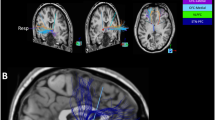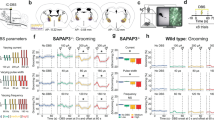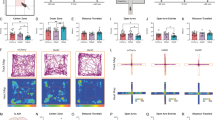Abstract
Deep brain stimulation (DBS) of the ventral capsule/ventral striatum (VC/VS) reduces anxiety, fear, and compulsive symptoms in patients suffering from refractory obsessive-compulsive disorder. In a rodent model, DBS-like high-frequency stimulation of VS can either enhance or impair extinction of conditioned fear, depending on the location of electrodes within VS (dorsal vs ventral). As striatal DBS activates fibers descending from the cortex, we reasoned that the differing effects on extinction may reflect differences in cortical sources of fibers passing through dorsal–VS and ventral–VS. In agreement with prior anatomical studies, we found that infralimbic (IL) and anterior insular (AI) cortices project densely through ventral–VS, the site where DBS impaired extinction. Contrary to IL and AI, we found that medial orbitofrontal cortex (mOFC) projects densely through dorsal–VS, the site where DBS enhanced extinction. Furthermore, pharmacological inactivation of mOFC reduced conditioned fear and DBS of dorsal-VS-induced plasticity (pERK) in mOFC neurons. Our results support the idea that VS DBS modulates fear extinction by stimulating specific fibers descending from mOFC and prefrontal cortices.
Similar content being viewed by others
Log in or create a free account to read this content
Gain free access to this article, as well as selected content from this journal and more on nature.com
or
References
Ahmari SE, Spellman T, Douglass NL, Kheirbek MA, Simpson HB, Deisseroth K et al (2013). Repeated cortico-striatal stimulation generates persistent OCD-like behavior. Science 340: 1234–1239.
Baxter LR Jr., Saxena S, Brody AL, Ackermann RF, Colgan M, Schwartz JM et al (1996). Brain mediation of obsessive-compulsive disorder symptoms: evidence from functional brain imaging studies in the human and nonhuman primate. Semin Clin Neuropsychiatry 1: 32–47.
Berendse HW, Galis-de Graaf Y, Groenewegen HJ (1992). Topographical organization and relationship with ventral striatal compartments of prefrontal corticostriatal projections in the rat. J Comp Neurol 316: 314–347.
Burgos-Robles A, Vidal-Gonzalez I, Santini E, Quirk GJ (2007). Consolidation of fear extinction requires NMDA receptor-dependent bursting in the ventromedial prefrontal cortex. Neuron 53: 871–880.
Corcoran KA, Quirk GJ (2007). Activity in prelimbic cortex is necessary for the expression of learned, but not innate, fears. J Neurosci 27: 840–844.
Denys D, Mantione M, Figee M, van den Munckhof P, Koerselman F, Westenberg H et al (2010). Deep brain stimulation of the nucleus accumbens for treatment-refractory obsessive-compulsive disorder. Arch Gen Psychiatry 67: 1061–1068.
Do-Monte FH, Rodriguez-Romaguera J, Rosas-Vidal LE, Quirk GJ (2013). Deep brain stimulation of the ventral striatum increases BDNF in the fear extinction circuit. Front Behav Neurosci 7: 102.
Do-Monte FH, Quinones-Laracuente K, Quirk GJ (2015). A temporal shift in the circuits mediating retrieval of fear memory. Nature (in press).
Draganski B, Gaser C, Kempermann G, Kuhn HG, Winkler J, Buchel C et al (2006). Temporal and spatial dynamics of brain structure changes during extensive learning. J Neurosci 26: 6314–6317.
Figee M, Luigjes J, Smolders R, Valencia-Alfonso CE, van Wingen G, de Kwaasteniet B et al (2013). Deep brain stimulation restores frontostriatal network activity in obsessive-compulsive disorder. Nat Neurosci 16: 386–387.
Gabbott PL, Warner TA, Jays PR, Salway P, Busby SJ (2005). Prefrontal cortex in the rat: projections to subcortical autonomic, motor, and limbic centers. J Comp Neurol 492: 145–177.
Gradinaru V, Mogri M, Thompson KR, Henderson JM, Deisseroth K (2009). Optical deconstruction of parkinsonian neural circuitry. Science 324: 354–359.
Greenberg BD, Gabriels LA, Malone DA Jr., Rezai AR, Friehs GM, Okun MS et al (2010a). Deep brain stimulation of the ventral internal capsule/ventral striatum for obsessive-compulsive disorder: worldwide experience. Mol Psychiatry 15: 64–79.
Greenberg BD, Rauch SL, Haber SN (2010b). Invasive circuitry-based neurotherapeutics: stereotactic ablation and deep brain stimulation for OCD. Neuropsychopharmacology 35: 317–336.
Haber SN, Behrens TE (2014). The neural network underlying incentive-based learning: implications for interpreting circuit disruptions in psychiatric disorders. Neuron 83: 1019–1039.
Haber SN, Kim KS, Mailly P, Calzavara R (2006). Reward-related cortical inputs define a large striatal region in primates that interface with associative cortical connections, providing a substrate for incentive-based learning. J Neurosci 26: 8368–8376.
Hoover WB, Vertes RP (2007). Anatomical analysis of afferent projections to the medial prefrontal cortex in the rat. Brain Struct Funct 212: 149–179.
Hoover WB, Vertes RP (2011). Projections of the medial orbital and ventral orbital cortex in the rat. J Comp Neurol 519: 3766–3801.
Kim SC, Jo YS, Kim IH, Kim H, Choi JS (2010). Lack of medial prefrontal cortex activation underlies the immediate extinction deficit. J Neurosci 30: 832–837.
Laurent V, Westbrook RF (2009). Inactivation of the infralimbic but not the prelimbic cortex impairs consolidation and retrieval of fear extinction. Learn Mem 16: 520–529.
LeDoux JE, Iwata J, Cicchetti P, Reis DJ (1988). Different projections of the central amygdaloid nucleus mediate autonomic and behavioral correlates of conditioned fear. J Neurosci 8: 2517–2529.
Mailly P, Aliane V, Groenewegen HJ, Haber SN, Deniau JM (2013). The rat prefrontostriatal system analyzed in 3D: evidence for multiple interacting functional units. J Neurosci 33: 5718–5727.
Maroun M, Kavushansky A, Holmes A, Wellman C, Motanis H (2012). Enhanced extinction of aversive memories by high-frequency stimulation of the rat infralimbic cortex. PLoS One 7: e35853.
McCracken CB, Grace AA (2007). High-frequency deep brain stimulation of the nucleus accumbens region suppresses neuronal activity and selectively modulates afferent drive in rat orbitofrontal cortex in vivo. J Neurosci 27: 12601–12610.
McGeorge AJ, Faull RL (1989). The organization of the projection from the cerebral cortex to the striatum in the rat. Neuroscience 29: 503–537.
Menzies L, Chamberlain SR, Laird AR, Thelen SM, Sahakian BJ, Bullmore ET (2008). Integrating evidence from neuroimaging and neuropsychological studies of obsessive-compulsive disorder: the orbitofronto-striatal model revisited. Neurosci Biobehav Rev 32: 525–549.
Milad MR, Furtak SC, Greenberg JL, Keshaviah A, Im JJ, Falkenstein MJ et al (2013). Deficits in conditioned fear extinction in obsessive-compulsive disorder and neurobiological changes in the fear circuit. JAMA Psychiatry 70: 608–618 quiz 554.
Milad MR, Quirk GJ (2002). Neurons in medial prefrontal cortex signal memory for fear extinction. Nature 420: 70–74.
Milad MR, Rauch SL (2012). Obsessive-compulsive disorder: beyond segregated cortico-striatal pathways. Trends Cogn Sci 16: 43–51.
Milad MR, Vidal-Gonzalez I, Quirk GJ (2004). Electrical stimulation of medial prefrontal cortex reduces conditioned fear in a temporally specific manner. Behav Neurosci 118: 389–394.
Padilla-Coreano N, Do-Monte FH, Quirk GJ (2012). A time-dependent role of midline thalamic nuclei in the retrieval of fear memory. Neuropharmacology 62: 457–463.
Paxinos G, Watson C (1998) The Rat Brain in Stereotaxic Coordinates. Academic Press: San Diego, Vol 4th.
Price JL (2007). Definition of the orbital cortex in relation to specific connections with limbic and visceral structures and other cortical regions. Ann NY Acad Sci 1121: 54–71.
Quirk GJ, Russo GK, Barron JL, Lebron K (2000). The role of ventromedial prefrontal cortex in the recovery of extinguished fear. J Neurosci 20: 6225–6231.
Rauch SL, Dougherty DD, Malone D, Rezai A, Friehs G, Fischman AJ et al (2006). A functional neuroimaging investigation of deep brain stimulation in patients with obsessive-compulsive disorder. J Neurosurg 104: 558–565.
Rodriguez-Romaguera J, Do Monte FH, Quirk GJ (2012). Deep brain stimulation of the ventral striatum enhances extinction of conditioned fear. Proc Natl Acad Sci USA 109: 8764–8769.
Schilman EA, Uylings HB, Galis-de Graaf Y, Joel D, Groenewegen HJ (2008). The orbital cortex in rats topographically projects to central parts of the caudate-putamen complex. Neurosci Lett 432: 40–45.
Sesack SR, Deutch AY, Roth RH, Bunney BS (1989). Topographical organization of the efferent projections of the medial prefrontal cortex in the rat: an anterograde tract-tracing study with Phaseolus vulgaris leucoagglutinin. J Comp Neurol 290: 213–242.
Sierra-Mercado D, Padilla-Coreano N, Quirk GJ (2011). Dissociable roles of prelimbic and infralimbic cortices, ventral hippocampus, and basolateral amygdala in the expression and extinction of conditioned fear. Neuropsychopharmacology 36: 529–538.
St Onge JR, Stopper CM, Zahm DS, Floresco SB (2012). Separate prefrontal-subcortical circuits mediate different components of risk-based decision making. J Neurosci 32: 2886–2899.
Sweatt JD (2004). Mitogen-activated protein kinases in synaptic plasticity and memory. Curr Opin Neurobiol 14: 311–317.
Vertes RP (2004). Differential projections of the infralimbic and prelimbic cortex in the rat. Synapse 51: 32–58.
Vidal-Gonzalez I, Vidal-Gonzalez B, Rauch SL, Quirk GJ (2006). Microstimulation reveals opposing influences of prelimbic and infralimbic cortex on the expression of conditioned fear. Learn Mem 13: 728–733.
Wallis JD (2012). Cross-species studies of orbitofrontal cortex and value-based decision-making. Nat Neurosci 15: 13–19.
Wise SP (2008). Forward frontal fields: phylogeny and fundamental function. Trends Neurosci 31: 599–608.
Acknowledgements
We thank the members of the Silvio O. Conte Center for Research in OCD: Barry W Connors, Darin Dougherty, Emad N. Eskandar, Anthony A Grace, Benjamin D Greenberg, Mohammed R Milad, and Steven A Rasmussen for useful discussions. We also thank Julia F Lehman, Anna E. Borkowska-Belanger, Carlos Rodriguez, and Zarkalys Quintero for technical assistance. This work was supported by NIH grants P50 MH086400 (to SNH and GJQ), R37 MH058883 and R01 MH081975 (to GJQ), R36 MH105039 (to JRR), and the University of Puerto Rico President’s Office.
Author information
Authors and Affiliations
Corresponding author
Rights and permissions
About this article
Cite this article
Rodriguez-Romaguera, J., Do-Monte, F., Tanimura, Y. et al. Enhancement of Fear Extinction with Deep Brain Stimulation: Evidence for Medial Orbitofrontal Involvement. Neuropsychopharmacol 40, 1726–1733 (2015). https://doi.org/10.1038/npp.2015.20
Received:
Revised:
Accepted:
Published:
Issue date:
DOI: https://doi.org/10.1038/npp.2015.20
This article is cited by
-
Medial orbitofrontal cortical regulation of different aspects of Pavlovian and instrumental reward seeking
Psychopharmacology (2023)
-
The prefrontal cortex and OCD
Neuropsychopharmacology (2022)
-
Electrical stimulation of the bed nucleus of the stria terminalis reduces anxiety in a rat model
Translational Psychiatry (2017)
-
Deep Brain Stimulation in Animal Models of Fear, Anxiety, and Posttraumatic Stress Disorder
Neuropsychopharmacology (2016)
-
The effects of methylphenidate and propranolol on the interplay between induced-anxiety and working memory
Psychopharmacology (2016)



